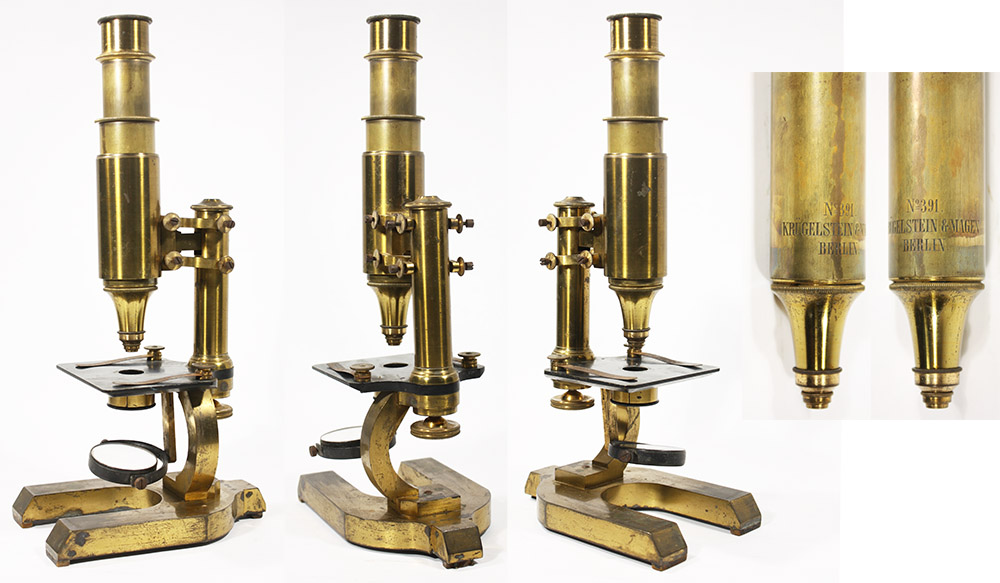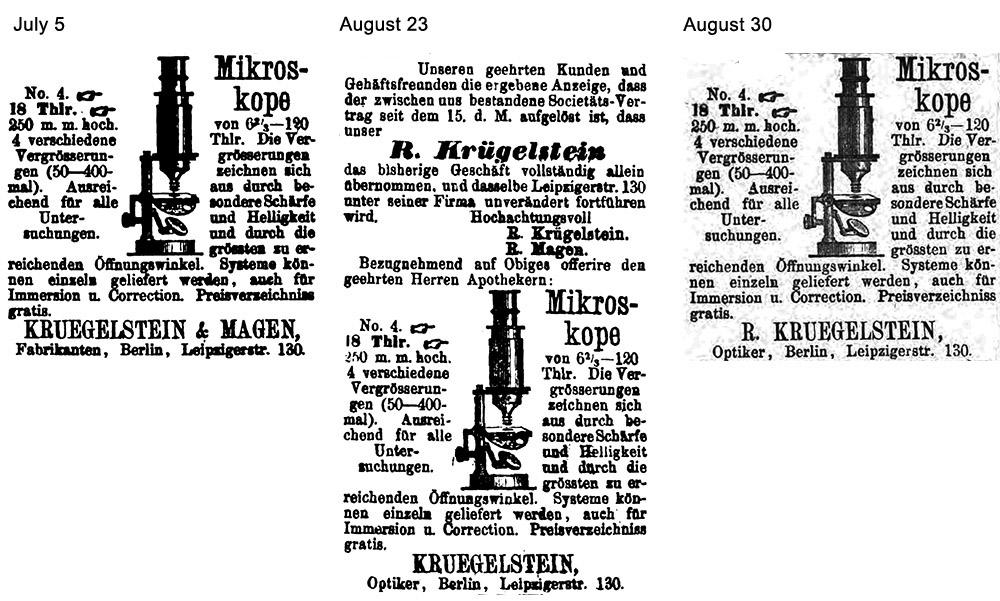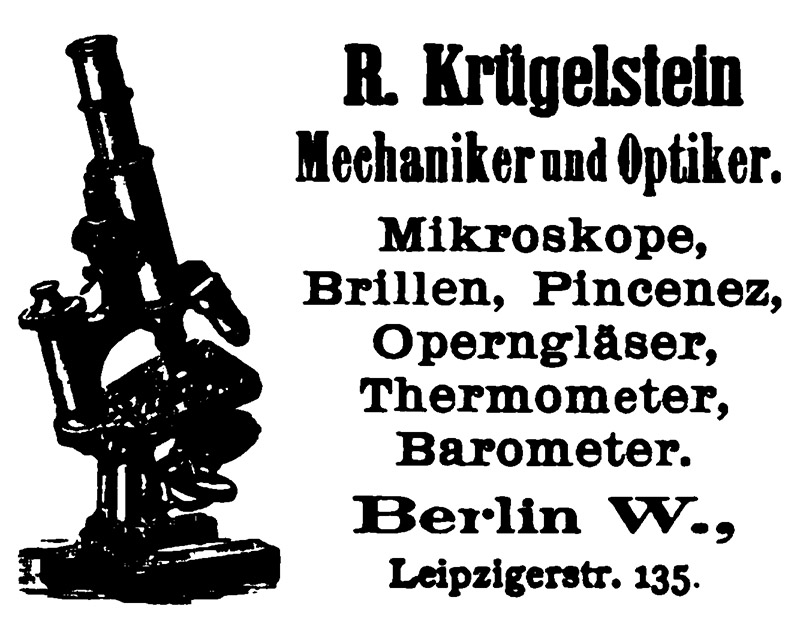Rudolf Krügelstein, 1839 - ca. 1920
(Karl Ludwig) Richard Magen, 1842 - 1904
by Brian Stevenson
last updated March, 2020
Rudolf Krügelstein operated shop in Berlin between 1865 and 1920, producing microscopes and other optical/scientific instruments. To judge from known serial numbers, his output appears to have been rather modest. It is possible that he retailed microscopes from other manufacturers during his business’ last decades.
Nonetheless, Krügelstein produced microscopes with unique features, and should be considered for inclusion in collections. His initial instruments possessed C-shaped lower limbs, with the fine-focus adjustment knob located underneath the stage (Figure 1). This design was used by several other German microscope manufacturers of the 1860s and afterwards. Krügelstein’s later, distinctive design instead made the upper limb into a C-shape, with the fine-focus control extending down, toward the stage (Figures 2-4).
For a brief period, between 1867 and 1871, Krügelstein took Richard Magen as a junior partner (Figures 6 and 7). Figure 1 shows one of their microscopes, with serial number 391. After the separation, Magen is known to have produced some microscopes; notably hand-held “salon” or “classroom” microscopes (Figure 8). No microscopes that are signed by Magen are known to me.
The Krügelstein & Magen / Krügelstein microscopes shown in Figures 1-4 feature “parallel linkage” devices that connect the upright limb to the body tube. The fine-focus screw in the limb tilts a central rod that is also connected to the body tube, and thereby raises/lowers the body. The parallel linkages are attached at four pivoting points on each side, and hold the body tube in position during focus adjustments. This mechanism was reportedly invented around the mid-1860s by another Berlin microscope maker, Ernst Gundlach (1835 - ca. 1910). Krügelstein and Magen evidently borrowed their colleague’s design. However, there is no evidence that either worked for Gundlach. Indeed, several features of the Krügelstein & Magen microscope illustrated in Figure 1 argue against a connection between the two firms. Foremost, the objective lens on the Krügelstein and Magen microscope has a female fitting, whereas contemporary Gundlach microscopes have objective lenses with male threads, evidence of different trains of thought on microscope construction.

Figure 1.
Circa 1867-1871 Krügelstein and Magen microscope, with serial number 391. The makers’ names and the serial number are engraved on the body tube, at a position that is generally not visible when the microscope is in use. This instrument is very similar to styles of other German manufacturers of the period, such as Gundlach and Seibert.

Figure 2.
Krügelstein’s distinctive microscope body, with a C-shaped upper limb and downward-facing fine-focus control knob. The example bears serial number 1041, and likely dates from shortly after the 1871 breakup of Krügelstein and Magen. The foot and limb are cast iron, which probably would have reduced the price. A much later Krügelstein microscope, with the highest known serial number of 2761, is essentially identical to the illustrated example - see https://www.microscope-antiques.com/krugelblack.html.

Figure 3.
Krügelstein microscope 2036, which is essentially the same as that shown in Figure 2. Subtle differences include the shape of the foot. Both green- and black-painted examples are known. Adapted with permission from https://www.musoptin.com/item/berliner-mikroskop.

Figure 4.
An unsigned microscope that bears strong resemblance to the signed Krügelstein microscopes shown in Figures 2 and 3. It bears a serial number, 1715. It is made entirely of brass, rather than iron and brass, and is far more finely finished than the examples shown above. Adapted with permission from https://www.microscope-antiques.com/krugelbrass.html

Figure 5.
A relatively simple compound microscope, signed “R. Krügelstein”. It is very similar to the model that was featured in advertisements around 1871 (see Figure 7). Coarse focus by drawing the body tube. Fine focus by a screw that tilts the stage. Adapted for nonprofit, educational purposes from an auction catalogue.
Rudolf Krügelstein’s marriage record tells us that he was born on October 12, 1839. He married Nathalie Marie Leist on July 7, 1864, in Berlin. That marriage implies that he had a stable job at the time. Where he worked, or with whom Krügelstein trained, are not known.
Krügelstein first appeared in the Berliner Adreßbuch in the 1866 edition, indicating that he began his business during 1865 (Figure 6). He was described as a “mechaniker”, located at 18 Neuenburger Strasse. The next year’s edition shows a short move, to 115 Alexandrinen Strasse.
Richard Magen (born December 22, 1842) joined as a partner in 1867. An article in Die Honigbiene during that year described a new microscope from the partners. Their address was still at 115 Alexandrinen Strasse. The 1868 Berliner Adreßbuch listed them at Leipziger Strasse, indicating a move during later in 1867. Krügelstein was to remain at that location through the turn of the century.
A series of 1870-1871 advertisements included an illustration of a relatively simple compound microscope (Figure 7). Those advertisements also documented the dissolution of the Krügelstein and Magen partnership: one announced that the business had ended on August 15, 1871, and that the shop at 130 Leipziger Strasse would continue under ownership of Krügelstein alone.
Magen did not appear in the Berliner Adreßbuch for the following two years. He is next known from a series of 1873 advertisements for hand-held “school” or “salon” microscopes (Figures 8 and 9). No microscopes signed by Magen alone are known to have survived. Later publications referred to prisms and other devices made by Magen, but not microscopes, so he may have ceased to produce them soon after leaving Krügelstein.
Beginning around 1875, a number of advertisements from Krügelstein boasted of a newly constructed microscope with a “senkrechter Mikrometerbewegung des Tubus” (“vertical micrometer adjustment to the tube”). This may have referred to the designs illustrated in Figures 2-4.
An 1898 advertisement from Krügelstein shows an illustration of a microscope that is very similar to those made by Zeiss (Figure 13). This may indicate that he was copying the designs of major manufacturers. Alternatively, it may be that his relatively small enterprise was retailing other makers’ microscopes.
Richard Magen died on January 4, 1904. An address book of German instrument-makers from the time of his death stated that Magen specialized in “Planprallelspiegel, Hohlspiegel, Glasskalen, Interferenzgitter für Schulen, Planparallelglas, Metalspiegel” (“Plane-parallel mirrors, concave mirrors, glass scales, interference grids for schools, plane-parallel glass, metal mirrors”). Magen’s business was continued by one Albert Sass, whose advertisements described his production of instruments with fine divisions, and galvanometers (Figure 14).
The 1916 entry for Rudolf Krügelstein in the Berliner Adreßbuch stated that he was an optician and mechanic who specialized in microscopes (Figure 15). He last appeared in the Berliner Adreßbuch in the 1920 edition. I have not located a record of his death, but he is presumed to have died around that time. He would have turned 81 years old in 1920.

Figure 6.
Extracts from the “Berliner Adreßbuch”. Rudolf Krügelstein was first listed in 1866 (published at the end of 1865), described as a “mechaniker” at 18 Neuenburger Strasse. The next year, he had moved a short distance to 115 Alexandrinen Strasse. The 1868 edition (published at the end of 1867) shows him in partnership with Richard Magen, who worked as mechanics and opticians, microscope-makers, at 130 Leipziger Strasse.

Figure 7.
Advertisements from 1871 that document the breakup of Krügelstein and Magen. The partners advertised together through July. An August 23 advertisement announced that the partnership had been dissolved, and later advertisements came from Krügelstein alone. The illustrated microscope is similar to that shown above in Figure 5, with the exception that the control knob for the stage-tilting fine-focus mechanism was located behind the limb, rather than below the stage. Several other Berlin-based microscope makers also made instruments with similar fine-focus mechanisms, including Paul Waechter, F.W. Schieck, and Schmidt & Haensch. Advertisements from Pharmazeutische Zeitung

Figure 8.
An 1873 advertisement by Richard Magen, which highlighted his classroom microscope. From “Deutsche Schulgesetz-Sammlung”.

Figure 9.
Another 1873 advertisement by Richard Magen, from “Deutsche Schulgesetz-Sammlung”.

Figure 10.
An 1875 advertisement from Rudolf Krügelstein, announcing a new microscope with a “senkrechter Mikrometerbewegung des Tubus” (“vertical micrometer adjustment to the tube”). This may have referred to the designs illustrated in Figures 2-4. From “Deutsche Apotheker-Zeitung”.

Figure 11.
An 1875 advertisement, from J. Tiemann’s “Leitfaden für die Praktische Mikroskopische Untersuchung des Schweinfleisches auf Trichinen”.

Figure 12.
An 1892 Krügelstein advertisement. He then sold microscopes, photographic apparatus, and chemicals. From “Zeitschrift für wissenschaftliche Mikroskopie und Mikroskopische Technik”.

Figure 13.
An 1893 advertisement, from “Jahresbericht über die Fortschritte in der Lehre von den Pathogenen Mikroorganismen”.

Figure 14.
An 1898 advertisement, with products that included microscopes, eye glasses, opera glasses, thermometers, and barometers. The illustrated microscope resembles those of large manufacturers such as Zeiss. From “Himmel und Erde”.

Figure 15.
Albert Sass took over Richard Magen’s business after the latter’s death. Advertisement from 1908.

Figure 16.
Entries for Rudolf Krügelstein from the “Berliner Adreßbuch”. In 1916, he was described as a specialist in microscopes. The 1920 entry is the last known record of Krügelstein. He was not listed in subsequent editions. He turned 81 in 1920.
Acknowledgements
Thank you to Barry Sobel and Timo Mappes for permission to use images from their collections, and to Joe Zeligs for helpful insights.
Resources
Berliner Adreßbuch (1864 - 1922) accessed through https://digital.zlb.de/viewer/cms/141/
Death record of Richard Magen (1904) accessed through ancestry.com
Deutsche Apotheker-Zeitung (1875) Advertisements from R. Krügelstein, Vol. 10
Deutsche Schulgesetz-Sammlung (1873) Advertisements from R. Magen, Vol. 2
Himmel und Erde (1898) Advertisement from R. Krügelstein, Vol. 10
Die Honigbiene (1867) “Magen und Krügelstein”, Vol. 5, pages 63-64
Jahresbericht über die Leistungen und Fortschritte im Gebiete der Ophthalmologie (1888) “Radialmikrometer und Zeichenschemata können von R. Magen, Optiker, Berlin NW. Philippstrasse 21 bezogen werden”, page 6
Jahresbericht über die Fortschritte in der Lehre von den Pathogenen Mikroorganismen (1893) Advertisement from R. Krügelstein
Kladderadatsch Berlin (1870) Advertisements from Krügelstein and Magen, Vol. 23
Marriage record of Rudolf Krügelstein and Nathalie Marie Leist (1864) accessed through ancestry.com
Marriage record of Richard Magen and Catherine Iversen (1877) accessed through ancestry.com
Pharmazeutische Zeitung (1871) Advertisements from Krügelstein and Magen, and from R. Krügelstein, Vol. 16
Sobel, Barry (accessed March, 2020) “Seibert ‘Large No.2’ microscope”, https://www.microscope-antiques.com/seibert.html
Strobel, Friedrich (1905) “Magen, Rich., Optiker, NW., Scharnhorststr. 34a, Spex. Planprallelspiegel, Hohlspiegel, Glasskalen, Interferenzgitter für Schulen, Planparallelglas, Metalspiegel”, Adressbuch der lebenden Physiker, Mathematiker und Astronemen, J.A. Barth, Leipzig, page 19
Taschenbuch für Prazisionsmechaniker, Optiker, Elektromechaniker und Glasinstrumentenmacher (1908) Advertisement from Albert Sass
Tiemann, Johann C.W.F. (1875) Leitfaden für die Praktische Mikroskopische Untersuchung des Schweinfleisches auf Trichinen, W.G. Korn, Breslau, advertisement from R. Krügelstein, back of book
Zeitschrift für Wissenschaftliche Mikroskopie und Mikroskopische Technik (1892) Advertisement from R. Krügelstein, Vol. 9















